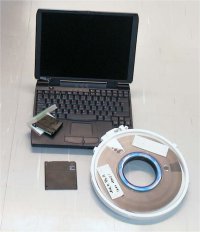Backups and migration ensure data usability
Matti Heinonen
The primary function of FSD is to archive and disseminate social science research data for secondary use. The implications of this are self-evident: it is crucial that the archived data are made usable.
Data usability can be divided roughly into two parts: scientific and technical usability. The former means that in addition to the actual quantitative data, all the relevant documents are archived. The technical usability, on the other hand, implies that the data are stored in such a manner that they can be read and processed - now, as well as in the future. This is best ensured by backups and migration.
Backup secures current usage

 Backup means that the existing data holdings are copied in various media. Backups have at least two significant advantages: First of all, they prevent data corruption that might result from some physical damage to the media (hard disk failure, etc.). And secondly, since at least one of the copies is kept at a different physical location, the data remains preserved in case of a fire, for example. Backup means that the existing data holdings are copied in various media. Backups have at least two significant advantages: First of all, they prevent data corruption that might result from some physical damage to the media (hard disk failure, etc.). And secondly, since at least one of the copies is kept at a different physical location, the data remains preserved in case of a fire, for example.
Technically speaking, making a backup copy is quite a straightforward procedure. All the necessary methods and technologies are available. The tricky part is to apply them in practice, and sometimes this is easier said than done.
Migration secures future usage
During migration, data holdings are configured to match some other data processing system. This is necessary when, for instance, the operating system or statistical software has become obsolete or discarded. The ageing hardware or data storage system can also make migration topical.
The process is complicated by the fact that it is difficult to predict when exactly migration is needed. It is evident that both the software and hardware will eventually become outdated, but it is virtually impossible to say when exactly it will happen, and what kind of substitutive systems will be available. It is, therefore, necessary to keep a close eye on the general development of information technology, and to actively evaluate new systems. In addition, migration is much simpler if one has chosen storage formats that can be easily transformed. In practice this means that the open, standardised formats - supported by a number of vendors - are favoured over the proprietary ones.
Vocabulary:
Media refers to the technical storage material, including paper, magnetic tape, hard disk, diskette and CD-rom.
Back to text.
Format refers to storage format within the media (SPSS portable file, SPSS .sav file, Microsoft Excel spreadsheet, and Microsoft Word document, etc.).
Back to text.
Top of page | Privacy Policy
|